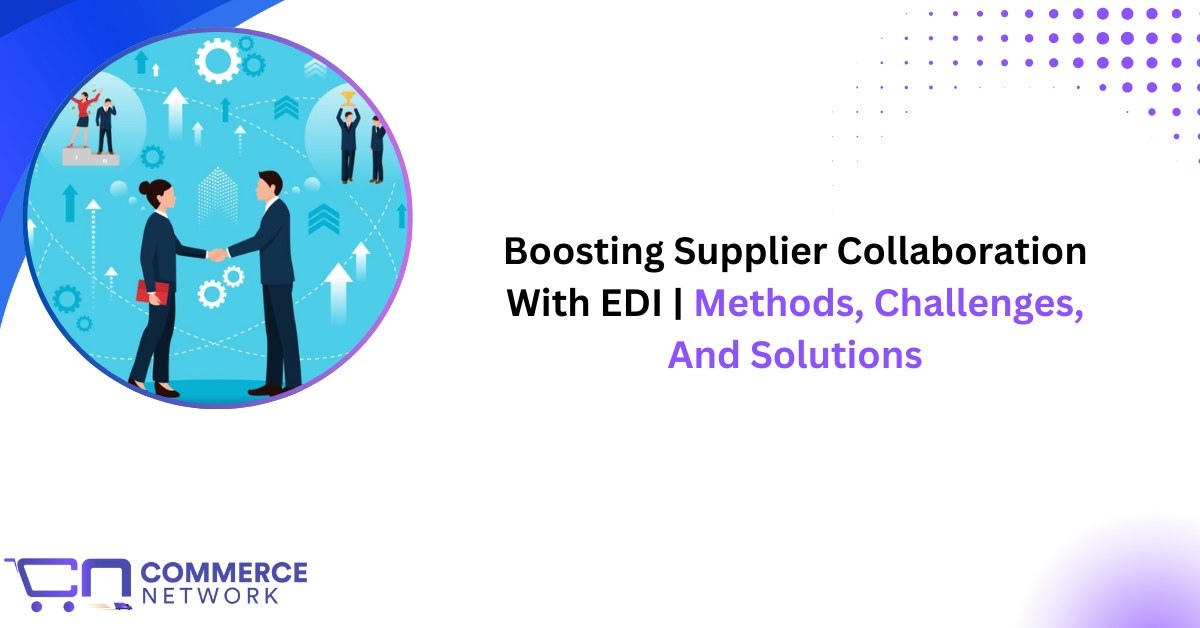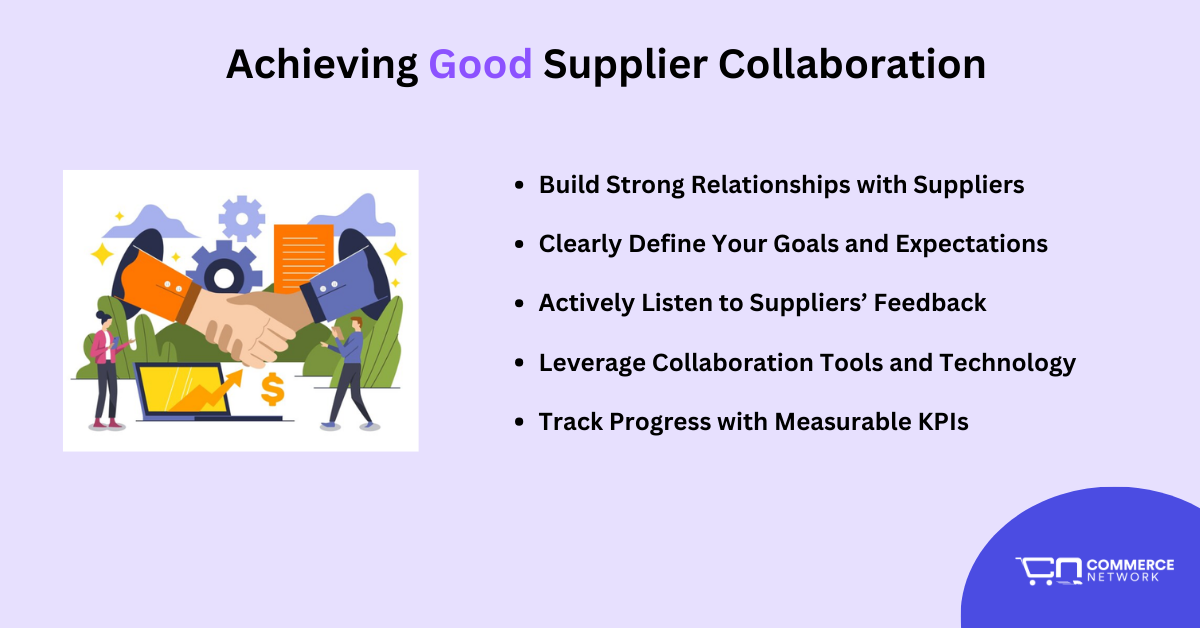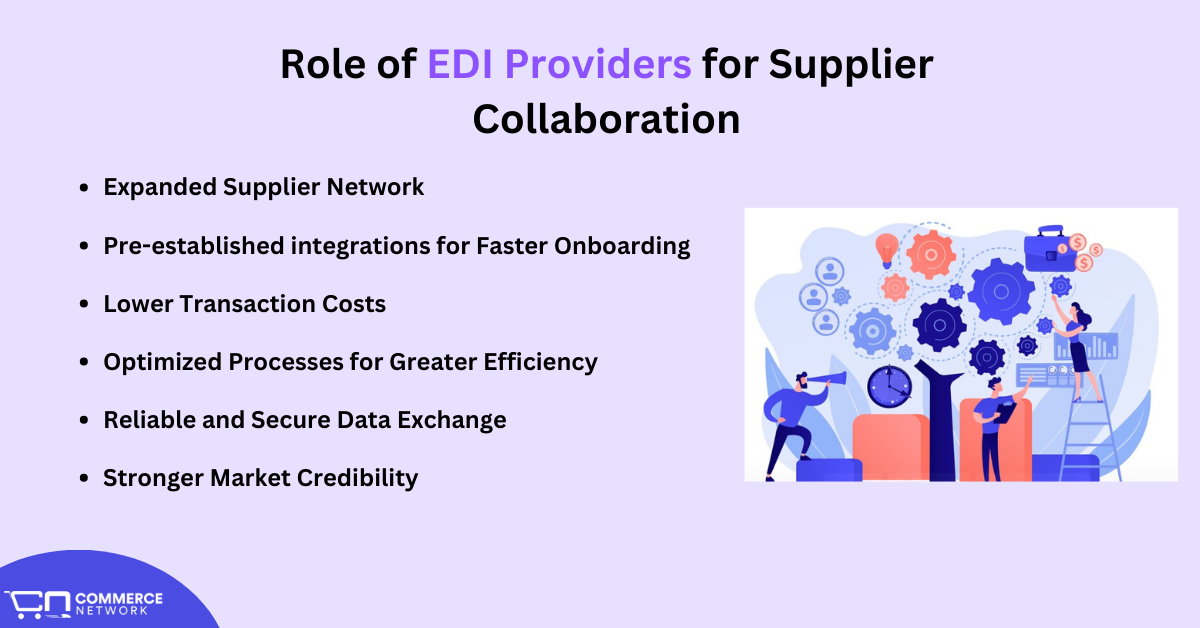
Key Highlights:
Suppliers are the cornerstone of any business. They supply products, from manufacturers to the buyers helping them procure items essential for operations.
Businesses boosting their engagement with suppliers find it simple to obtain necessary supplies even in complex environmental, geopolitical, logistical, technological, or economic situations.
Efficient collaboration with suppliers must be at the top of the priority list of any business owner if they want an uninterrupted supply of goods, improve business advantage, and not have recurring problems with supply chain procurement.
Electronic Data Interchange (EDI) emerges as a viable method of coordinating and collaborating with suppliers with its automated process, historical legacy, and reliable security, especially in terms of large-scale B2B and B2G e-commerce.
In this article, we aim to explain how business owners can utilize EDI to effectively collaborate with their suppliers and improve the supply chain in dynamic modern e-commerce scenarios.
EDI suppliers use EDI to perform business exchanges with their trading partners. They supply products and services to their partners in the supply chain network through EDI documents like purchase orders, invoices, shipping notices, etc.
Conducting business with EDI suppliers is automatic and electronic, meaning it will have little to no manual intervention.
As the name suggests, supplier collaboration refers to businesses collaborating with suppliers for an enhanced procurement process. Collaboration with suppliers helps in maintaining good relationships, enables effective communication exchanges, and streamlines procurement processes for businesses.

A business needs to perform certain tasks for smooth supplier collaboration. If you are a business trying to leverage supplier collaboration to improve performance, you need to:
1. Build Strong Relationships with Suppliers
Take the initiative to connect regularly with suppliers. Treat them as partners, not just vendors, by scheduling check-ins and sharing updates. When you invest in these relationships, you’ll foster trust and loyalty, which often leads to better problem-solving, innovation, and long-term cost savings.
2. Clearly Define Your Goals and Expectations
Start by openly communicating your business objectives, timelines, and quality standards. When suppliers understand exactly what you need, they can align their efforts to meet your priorities. This reduces confusion, speeds up decision-making, and ensures everyone works toward the same outcomes.
3. Actively Listen to Suppliers’ Feedback
Create space for suppliers to voice concerns or ideas. Ask questions like, “What challenges are you facing?” or “How can we improve this process?” By valuing their input, you’ll uncover inefficiencies, build mutual respect, and find creative solutions that benefit both sides.
4. Leverage Collaboration Tools and Technology
Invest in digital solutions like EDI, supplier portals, Slack, Trello, or cloud-based ERP platforms to streamline communication. These tools keep everyone on the same page, reduce delays, and make it easier to share real-time updates. The result? Faster workflows, fewer errors, and a more transparent partnership.
5. Track Progress with Measurable KPIs
Set clear metrics like on-time delivery rates or defect percentages to evaluate performance. Regularly review these KPIs with suppliers to celebrate wins and address gaps. This keeps accountability high, drives continuous improvement, and ensures your collaboration delivers tangible results.
By adopting these practices, you’ll turn suppliers into strategic allies. Stronger communication cuts costs and risks, proactive problem-solving boosts efficiency and shared accountability builds a resilient supply chain. Start small, prioritize consistency, and watch the collaboration become your competitive edge.

Using Electronic Data Interchange in collaborating with suppliers provides several benefits for a business. An EDI-driven supplier collaboration system helps through:
1. Automated Order Lifecycle Visibility
How It Works:
Use EDI 850 (Purchase Order) to initiate orders and EDI 855 (Purchase Order Acknowledgment) for suppliers to confirm acceptance, quantities, and delivery dates.
Track all transaction statuses (e.g., order sent, acknowledged, shipped) via EDI 997 (Functional Acknowledgment) to ensure documents are received and processed without errors.
Benefit:
Suppliers and buyers share real-time visibility into order progress. Delays or discrepancies (e.g., mismatched quantities in EDI 855) trigger immediate alerts, reducing miscommunication and stockouts.
Also Read: How To Handle High-Volume Orders With EDI In E-Commerce
2. Dynamic Order Adjustments with Cost Impact
How It Works:
Send EDI 860 (Purchase Order Change Request) to modify orders (e.g., reduce quantities, change delivery dates).
Automatically update EDI 810 (Invoice) to reflect adjustments (e.g., prorated costs for reduced orders) and validate changes with EDI 997.
Benefit:
Suppliers adjust to changing demands easily, while invoices stay aligned with revised terms. Financial disputes drop because both parties agree to changes before invoicing.
3. Preemptive Dispute Resolution via Invoice Reconciliation
How It Works:
Cross-reference EDI 810 (Invoice) with original EDI 850 and EDI 855 data (e.g., agreed prices, quantities).
Flag mismatches (e.g., overcharges) using EDI 997 error codes and auto-send correction requests to suppliers.
Benefit:
Catches billing errors early, reducing manual reconciliation work. Suppliers fix issues before payment cycles, improving cash flow trust.
Also Read: A Guide To EDI Invoicing
4. Compliance-Driven Order Execution
How It Works:
Embed compliance requirements (e.g., sustainability certifications, and government regulations) directly into EDI 850 purchase orders.
Require suppliers to confirm compliance in EDI 855 responses. Use EDI 997 to reject non-compliant acknowledgments and escalate unresolved issues.
Benefit:
Ensures suppliers meet regulatory standards upfront, avoiding costly cancellations or delays later.
5. Closed-Loop Defect Resolution Workflow
How It Works:
Trigger EDI 860 to request replacements or credits for defective goods, citing specific defect codes.
Auto-adjust EDI 810 invoices to deduct costs for defective items and validate adjustments with EDI 997.
Benefit:
Turns quality issues into systematic, traceable processes. Suppliers address defects faster, and buyers recover costs without manual negotiations.
Each feature leverages specific EDI documents to solve a unique collaboration pain point:
With these EDI documents, businesses simplify complexity while maintaining end-to-accountability. Suppliers stay focused on critical transactions, reducing training burdens and fostering trust through transparency.
1. Real-Time Demand Forecasting with EDI 850 (Purchase Order)
Challenges:
Inconsistent Forecast Data: Frequent EDI 850 updates based on forecasts may include errors (e.g., incorrect quantities or delivery dates).
Delayed Supplier Confirmations: Suppliers might not promptly acknowledge updated orders via EDI 855, causing misalignment.
Solutions:
Automate EDI 850 Validation: Use schema checks to validate forecast-driven purchase orders (e.g., flagging unrealistic quantities) before sending.
Enforce EDI 855 Timelines: Require suppliers to send EDI 855 (Purchase Order Acknowledgment) within a set window. Use EDI 997 (Functional Acknowledgment) to confirm receipt and track response times.
2. Compliance Management via EDI 850 and EDI 855
Challenges:
Missing Compliance Data: Suppliers may omit certifications or regulatory details in EDI 855 responses.
Manual Follow-Ups: Chasing suppliers for compliance proof slows processes.
Solutions:
Embed Compliance Requirements in EDI 850: Include mandatory fields in purchase orders (e.g., "Certification Code Required").
Automate EDI 855 Compliance Checks: Configure systems to reject EDI 855 responses lacking compliance data and trigger EDI 997 error notifications for quick resolution.
Recommended: EDI Compliance In B2B And B2G Trading Environments
3. Dynamic Payment Terms Using EDI 810 (Invoice)
Challenges:
Invoice-Payment Misalignment: Suppliers may submit EDI 810 invoices that don’t reflect agreed-upon terms (e.g., discounts for on-time EDI 855 confirmations).
Manual Reconciliation: Matching invoices to order changes (EDI 860) is time-consuming.
Solutions:
Link EDI 810 to EDI 855 Performance: Auto-adjust invoice terms (e.g., early payment discounts) if suppliers meet EDI 855 acknowledgment deadlines.
Sync EDI 860 (Order Changes) with EDI 810: Automatically update invoices when order changes occur, using EDI 997 to confirm both parties receive revised documents.
4. Supplier Portal Integration with EDI 997 Tracking
Challenges:
Low Portal Engagement: Suppliers may avoid using the portal to manage EDI 850/855/860 transactions.
Unresolved Document Errors: Portal users might ignore EDI 997 error notifications.
Solutions:
Gatekeep Portal Access with EDI 997: Require suppliers to resolve EDI 997-flagged issues (e.g., invalid EDI 855 data) before submitting new orders.
Embed EDI 997 Alerts in Portals: Display real-time document statuses (e.g., "Invoice 810 Accepted") to encourage proactive issue resolution.
5. Quality Feedback Loops via EDI 860 (Order Change Requests)
Challenges:
Ignored Change Requests: Suppliers may delay or reject EDI 860 submissions for defect-related adjustments.
Lack of Accountability: No clear link between defects and financial repercussions.
Solutions:
Enforce EDI 860 for Defects: Require suppliers to confirm quality-related changes via EDI 860 within a set timeframe.
Auto-Deduct Costs via EDI 810: If defects are reported, adjust invoice amounts in EDI 810 based on EDI 860 change requests. Use EDI 997 to notify suppliers of deductions.
Why This Works
With EDI 850, 855, 860, 810, and 997 documents, businesses maintain simplicity while addressing core collaboration challenges. Each document serves a distinct purpose:
This approach reduces complexity, minimizes training needs, and keeps suppliers focused on critical transactions.

Expanded Supplier Network
An EDI provider like Commerce Network with a well-established network of major suppliers gives businesses access to a broader pool of potential trading partners. This makes it easier to source new suppliers, diversify product offerings, and tap into new market opportunities.
Pre-established integrations for Faster Onboarding
With existing connections to large suppliers, the EDI provider simplifies and accelerates the onboarding process. Clients can quickly integrate with key suppliers without the hassle of building new connections from scratch.
Lower Transaction Costs
Since the EDI provider already facilitates transactions with major suppliers, they can offer cost-effective pricing for EDI services. This helps businesses cut down on transaction fees and other operational expenses associated with electronic data exchange.
Optimized Processes for Greater Efficiency
Years of experience handling transactions with large suppliers enable the EDI provider to refine and streamline its systems. As a result, businesses benefit from faster order processing, fewer errors, and improved overall efficiency.
Reliable and Secure Data Exchange
Major suppliers enforce strict EDI compliance and security standards. An EDI provider accustomed to working with these suppliers ensures a stable, secure, and compliant data exchange process, reducing risks of errors or disruptions.
Stronger Market Credibility
Partnering with a reputable EDI provider like Commerce Network enhances a business’s standing with large suppliers. This credibility can strengthen supplier relationships, improve contract negotiations, and open doors to better business opportunities.
Commerce Network Supplier Collaboration
Effective supplier collaboration is essential for businesses looking to optimize their supply chain, reduce costs, and improve efficiency. EDI plays a crucial role in this process by automating transactions, enhancing communication, and providing real-time visibility into operations. By leveraging EDI, businesses can streamline supplier relationships, reduce manual errors, and ensure seamless data exchange. As supply chains continue to evolve, adopting EDI-driven collaboration strategies will help companies stay competitive, strengthen partnerships, and drive long-term growth.
Improve Your B2B, B2G, and B2C Ecommerce?
Integrate EDI For Efficiency, Compliance, and Scalability?
Just Curious About EDI?
Give Us A Call
202-280-7060